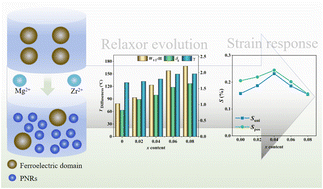The BiFeO3–BaTiO3 solid solution exhibits enhanced electric properties due to its modified phase structure with relaxor characteristics and reduced leakage current. Despite these advancements, the underlying mechanism behind the phase transition from a ferroelectric to a relaxor state in BF–BT ceramics remains largely unexplored. Here, the evolution of strain in (0.67 − x)BiFeO3–0.33BaTiO3–xBi(Mg0.5Zr0.5)O3 ceramics is investigated, with a focus on the strain transition from a ferroelectric to a relaxor phase. A strengthening of relaxor behavior is observed in the modified rhombohedral (R) and pseudocubic (PC) phase structure, resulting in optimal strain (Suni = 0.25%, Spos = 0.24%) at x = 0.04. The enhanced strain is attributed to the promotion of domain switching and the presence of strong random fields, with polar nanoregions integrating into a long-range ordered matrix. Furthermore, a gradual increase in strain with rising temperature is noted, driven by increased polarization and the expansion of ferroelectric domains. This study underscores the critical role of structural modifications in augmenting the electric response of BF–BT ceramics, thereby advancing the development of lead-free piezoelectric materials.
